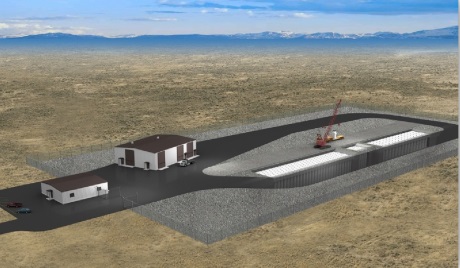A new remote-handled low-level waste (LLW) disposal facility should be in operation at the Idaho National Laboratory (INL) by October 2017. A $34 million contract for the facility's design and construction has now been awarded.
 |
| A conceptual design of the remote-handled LLW disposal facility (Image: INL) |
The US Department of Energy's (Doe's) INL supports its research into nuclear energy and naval nuclear reactors. Some of the LLW generated at INL is classified as remote-handled waste because its potential radiation dose is high enough to require additional protection of workers. Such wastes are those with radiation levels exceeding 2 millisieverts per hour at the surface of a container. They includes debris, used gloves and tools, as well as ion-exchange resins and filters.
Remote-handled LLW generated at INL has historically been disposed of onsite. However, the existing disposal facility within the INL Radioactive Waste Management Complex is set to close in 2017 as part of ongoing cleanup of the INL site.
Battelle Energy Alliance, which manages and operates INL on behalf of the DoE, has now awarded a contract worth $34 million to Areva to provide the engineering, construction and commissioning of a new facility.
The facility will be based on INL's existing operating remote-handled LLW disposal facility. It will include a support office and maintenance building, new paved roads, security fencing and systems, and utilities.
The underground disposal facility itself will consist of pre-cast concrete cylinders of varying diameters and lengths stacked on-end in various arrays depending on the origins of the radioactive waste. Each stacked cylinder will be placed on a concrete base and will have a separate removable concrete plug placed on the top of the cylinder to serve as a radiation shield and a water barrier.
The facility will initially consist of 225 concrete disposal vaults, almost 8 metres underground, with options to increase this to 400.
Construction of the new facility is scheduled to be completed by the end of September 2016 and the DoE readiness review process is required to be completed a year later. The facility is scheduled to begin operating in October 2017 and should then be in operation for up to 50 years.
The DoE expects to generate an estimated average volume of 150 cubic metres of remote-handled LLW annually at INL. The department will continue to dispose of contact-handled LLW, with lower levels of radiation, at acceptable off-site disposal facilities.
Researched and written
by World Nuclear News




_18570.jpg)
_18938.jpg)
_33584.jpg)
_82983.jpg)





